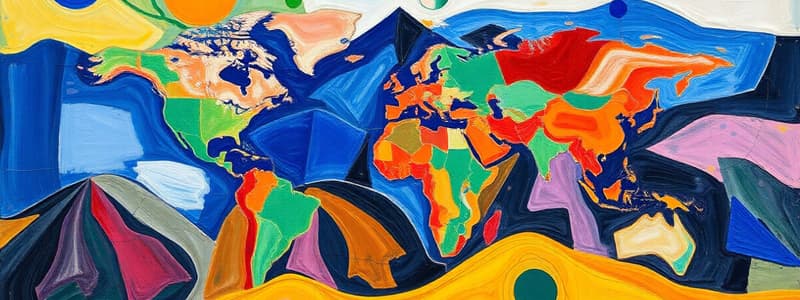Podcast
Questions and Answers
What is the primary focus of human geography?
What is the primary focus of human geography?
- Examining human activities and their interaction with the environment (correct)
- Studying climate and weather patterns
- Mapping geological features and resources
- Analyzing physical landforms and ecosystems
Which branch of geography deals with natural features and processes of the Earth?
Which branch of geography deals with natural features and processes of the Earth?
- Human Geography
- Cultural Geography
- Geospatial Technology
- Physical Geography (correct)
Which tool is primarily used for mapping and spatial analysis?
Which tool is primarily used for mapping and spatial analysis?
- Geographic Information Systems (GIS) (correct)
- Global Positioning System (GPS)
- Remote Sensing
- Topographic Maps
What does the concept of 'absolute location' refer to?
What does the concept of 'absolute location' refer to?
What are formal regions defined by?
What are formal regions defined by?
What does the term 'human-environment interaction' encompass?
What does the term 'human-environment interaction' encompass?
Which theory explains the size and distribution of human settlements?
Which theory explains the size and distribution of human settlements?
What is one of the current issues in geography linking to climate change?
What is one of the current issues in geography linking to climate change?
Flashcards are hidden until you start studying
Study Notes
Definition
- Geography is the study of places and the relationships between people and their environments.
Branches of Geography
-
Physical Geography
- Studies natural features: landforms, climate, vegetation, and ecosystems.
- Examines processes like erosion, weathering, and plate tectonics.
-
Human Geography
- Focuses on human activities: culture, economy, urban development.
- Analyzes how humans interact with the environment.
-
Geospatial Technology
- Involves tools like Geographic Information Systems (GIS), remote sensing, and GPS.
- Used for mapping, spatial analysis, and data visualization.
Key Concepts
-
Location
- Absolute location: exact coordinates (latitude and longitude).
- Relative location: position in relation to other places.
-
Place
- Physical characteristics: landforms, climate, plants, and animals.
- Human characteristics: architecture, culture, and population.
-
Region
- Areas defined by common features: physical (climate, landforms) or human (cultural, political).
- Types include formal, functional, and vernacular regions.
-
Movement
- Refers to the mobility of people, goods, and ideas.
- Examines patterns and systems of migration, trade, and communication.
-
Human-Environment Interaction
- Studies how humans adapt to and modify their environment.
- Includes concepts like sustainability, land use, and environmental degradation.
Important Tools and Techniques
-
Maps
- Types: topographic, thematic, political, and physical maps.
- Key elements: scale, symbols, and legend.
-
Remote Sensing
- Use of satellite or aerial imagery to gather information about the Earth's surface.
- Applications in agriculture, forestry, urban planning, and disaster management.
-
GIS (Geographic Information Systems)
- Software for capturing, managing, analyzing, and displaying spatial data.
- Enables complex spatial analysis and decision-making.
Notable Theories and Models
-
Central Place Theory
- Explains the size and distribution of human settlements.
- Introduces concepts of market areas and hierarchical organization.
-
Ravenstein's Laws of Migration
- Patterns of migration based on distance and economic factors.
- Highlights the demographic characteristics of migrants.
Current Issues in Geography
- Climate change and its impact on ecosystems.
- Urbanization and its effects on society and the environment.
- Globalization and cultural exchange.
- Resource distribution and geopolitical conflicts.
Definition
- Geography explores the interconnections between people and their environments, studying both places and relationships.
Branches of Geography
-
Physical Geography
- Investigates natural features such as landforms, climate, vegetation, and ecosystems.
- Analyzes Earth processes including erosion, weathering, and plate tectonics.
-
Human Geography
- Examines human activities related to culture, economy, and urbanization.
- Studies the interactions between humans and their environments.
-
Geospatial Technology
- Utilizes tools including Geographic Information Systems (GIS), remote sensing, and GPS.
- Essential for mapping, spatial analysis, and data visualization.
Key Concepts
-
Location
- Absolute location is defined by exact coordinates (latitude and longitude).
- Relative location describes position concerning other places.
-
Place
- Physical characteristics include landforms, climate, flora, and fauna.
- Human characteristics encompass architecture, culture, and demographic aspects.
-
Region
- Defined by common features, whether physical (climate, landforms) or human (cultural, political).
- Types of regions include formal, functional, and vernacular.
-
Movement
- Encompasses the mobility of people, goods, and ideas.
- Investigates migration, trade patterns, and communication systems.
-
Human-Environment Interaction
- Studies adaptation and modification of the environment by humans.
- Covers concepts such as sustainability, land use, and environmental degradation.
Important Tools and Techniques
-
Maps
- Various types: topographic, thematic, political, and physical.
- Essential elements include scale, symbols, and legend for interpretation.
-
Remote Sensing
- Employs satellite or aerial imagery for Earth surface analysis.
- Applications span agriculture, forestry, urban planning, and disaster management.
-
GIS (Geographic Information Systems)
- Software for managing and analyzing spatial data.
- Supports complex spatial analysis and aids in decision-making.
Notable Theories and Models
-
Central Place Theory
- Explains the spatial arrangement and distribution of human settlements.
- Introduces market areas and the hierarchical organization of cities.
-
Ravenstein's Laws of Migration
- Illustrates migration patterns influenced by distance and economic elements.
- Highlights the demographic traits of migrants.
Current Issues in Geography
- Climate change affecting ecosystems and biodiversity.
- Urbanization's impact on social structures and environmental conditions.
- Globalization enhancing cultural exchange and interconnectivity.
- Resource distribution leading to geopolitical conflicts and competition.
Studying That Suits You
Use AI to generate personalized quizzes and flashcards to suit your learning preferences.



